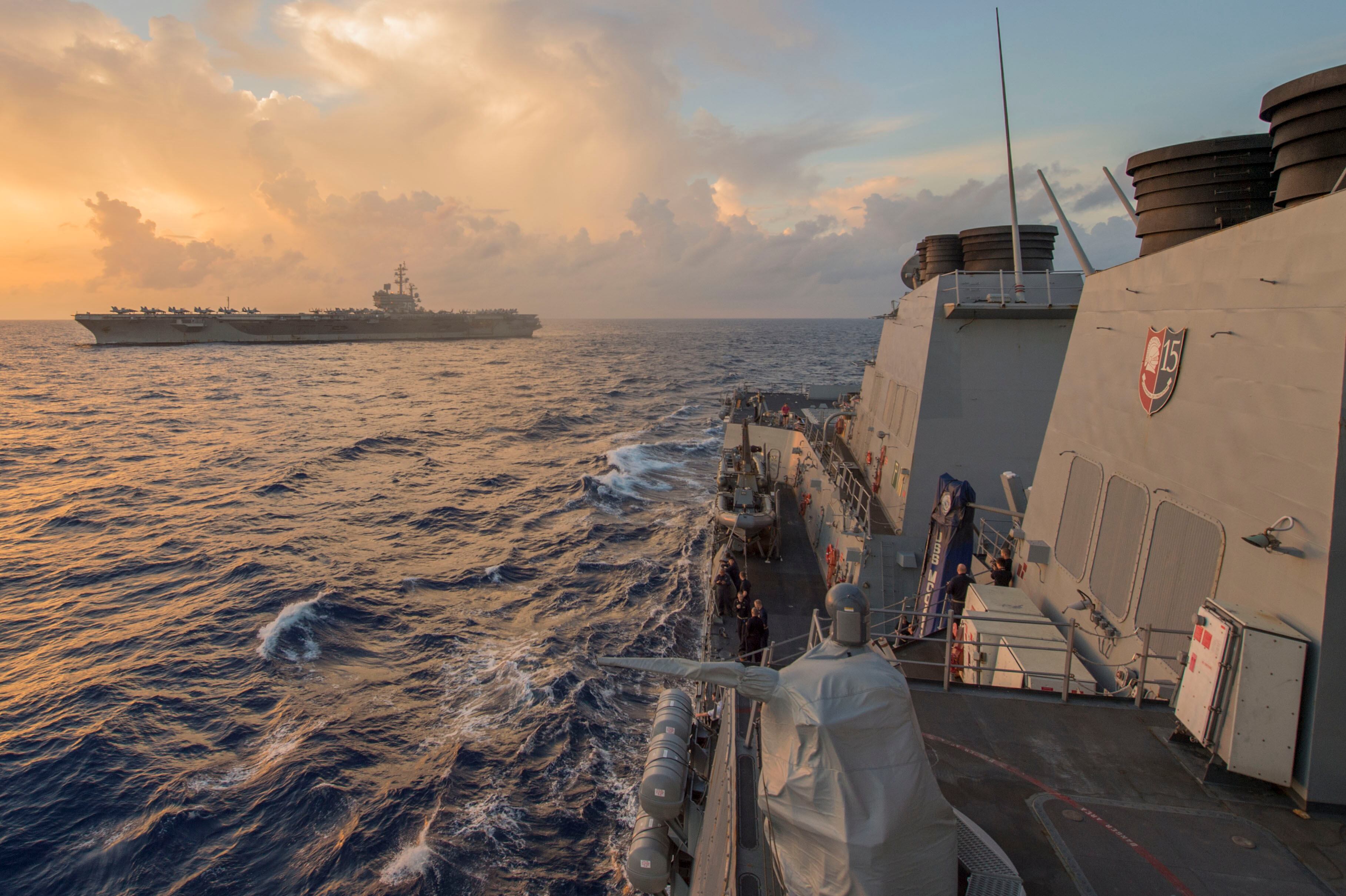The U.S. Navy’s top officer in Beijing meeting with his Chinese counterpart, raised U.S. concerns over China’s expansive actions in the South China Sea claims in a high-level visit with his counterpart in the Chinese navy. and its response to an international court’s ruling that its claims were invalid.
Adm. John Richardson, chief of naval operations, said he met with in an audio clip posted to the Navy’s that he Adm. Wu Shengli, the commander of the People's Liberation Army-Navy, for three hours and had a "very substantial discussion," which he characterized as open and honest. The meeting in Beijing came a few days after an international court ruled that many of China's historical claims and island-building offered no legal basis to controlling nearly all of the disputed South China Sea.
"We really covered the full spectrum of our relationship, from those areas where our cooperation and collaboration is doing very well," Richardson said, according to an audio clip. "But on the other hand we didn't dodge any of the more contentious issues regarding dispositions in the South China Sea, the Court of Arbitration Ruling and those issues, recognizing that only through being completely frank and honest are we going to make any progress in those areas."
The Chinese state media site Xinhua posted a readout off the discussion, saying Wu told Richardson that the Chinese would not stop its island construction projects in the Spratly Islands, which Beijing calls the Nansha Islands.
"We will never stop our construction on the Nansha Islands halfway," Xinhua quotes Wu saying. "The Nansha Islands are China's inherent territory, and our necessary construction on the islands is reasonable, justified and lawful."
A ruling by the Permanent Court of Arbitration in The Hague, Netherlands found the China’s claims to dominion of most of the South China Sea were baseless and also ruled that China could not claim any territorial or resource rights by building islands on features that otherwise not be entitled to such privileges.
China has rejected the court's ruling and has said it will not abide by it, raising the specter of continued tensions in the region.

U.S. and Chinese Navy leaders met in Beijing to discuss the South China Sea. China claims most of the South China Sea, but a tribunal ruled it has no legal basis to do so. The U.S. has vowed to operate wherever international law allows. Carrier Ronald Reagan and destroyer McCampbell were in the South China Sea on July 13.
Photo Credit: MC3 Elesia K. Patten/ Navy
Wu’s statement in Xinhua did not reference an ongoing dispute with the Philippines over Scarborough Shoal, a rich fishing ground less than 140 miles from Manila inside the Philippines's capital that is inside that country's exclusive economic zone; that China seized the reef in 2012 and has signaled it may build on it. from the county in 2012.
Chinese coast guard vessels have been chasing Philippine fishermen away ever since and that has not changed in the wake of the ruling, according to local media reports.
In the wake of After the ruling, which was seen by many analysts as a rebuke n embarrassment to Beijing, China has made several signs that it intends to maintain its posture in the South China Sea.
On Monday, Reuters reported that a senior Chinese admiral, Sun Jianguo, warned in a closed-door meeting that if the freedom of navigation operations by U.S. warships continued its so-called freedom of navigation patrols that it could end in disaster.
Reuters obtained a transcript of the event.
China, Sun said, was the biggest beneficiary of freedom of navigation and wouldn't do anything to damage it.
"But China consistently opposes so-called military freedom of navigation, which brings with it a military threat and which challenges and disrespects the international law of the sea," he said, according to a Reuters transcript of the event. "This kind of military freedom of navigation is damaging to freedom of navigation in the South China Sea, and it could even play out in a disastrous way."
However, maritime experts say these freedom of navigation patrols exercise the rights to which nation's are entitled and that failing to do so will reinforce Chinese claims. Top U.S. leaders, including the defense secretary, have vowed that the military will fly, sail and operate everywhere allowed under international law.
In October, the destroyer Lassen patrolled within made a freedom-of-navigation patrol within the 12-nautical-mile territorial limit of several features claimed by China and others in the region to challenge what the U.S. sees as "excessive claims." In January, the destroyer Curtis Wilbur did a similar patrol in the Paracel Islands.
China also announced Monday that it was planning to begin regular maritime patrol flights in the South China Sea with its bombers. The announcement in Xinhua specifically named Scarborough Shoal as being one of the features the bombers would patrol.
China also has announced more military exercises and plans to cordonlose off a large area of the South China Sea near Hainan Island, which it did in the run-up to the court of arbitration’s ruling July 12.
David B. Larter was the naval warfare reporter for Defense News.




